In B2B SaaS, few companies respond to reviews.
According to a survey by G2, 86% of B2B software buyers make their buying decision based on user reviews on third-party platforms. B2B software vendors have learned that getting reviews is important, yet only some are responding to reviews. Responding to those user reviews, whether positive or negative, can increase your chances of retaining a customer and winning a new account.
While some review sites don’t allow vendors to respond to reviews with users, others, like G2, TrustRadius, and PeerSpot, do. If you’ve been avoiding responding to reviews because you’re unsure how to respond, this article is for you.
In this article, you’ll learn the benefits of responding to reviews, the best ways how to respond to reviews, and some templates you can quickly adapt for your customer success team.
Why it's important to respond to user reviews
In January 2023, G2 reached a milestone of 2 million reviews on their software review site. This milestone shows that B2B users are vocal about their experiences with a product and are aware that their peers rely on their reviews to make buying choices.
Yet, most B2B SaaS companies don’t respond to user reviews. To get a sense of how rare it is, you can scroll through the reviews of the top companies on G2 or TrustRadius. So if you don’t respond to your user reviews, you might wonder, “What’s the big deal?”
The modern B2B buyer is looking for a way to make faster buying decisions. And since reviews are the digital equivalent of word of mouth, 92% of B2B buyers are more likely to purchase after reading a trusted review.
Responding to reviews has been found to create trust with buyers. In a survey commissioned by Yelp and conducted by Kelton, 88% of respondents said they are likelier to look past a negative review if they see that the business has responded to it and adequately addressed the issue.

“I talk with a lot of CM&A professionals. And I ask them what their review follow-up strategy is and how it’s executed. The silence speaks volumes”
Alison Bukowski, Head of Marketing at PeerSpot and TOP25 Customer Marketing & Advocacy Strategist
Alison of PeerSpot added, “Just because a customer leaves a positive review does not mean they’re happy and will stay happy – no action required. It’s the opposite. If you are able, take the time to demonstrate your appreciation for their time and feedback, and tell them SPECIFIC ways that you will leverage that feedback – make them feel appreciated and let them know how beneficial that feedback will be to your entire organization. Oh, and if you receive a critical review, hold yourself to a higher standard and follow-up on it, not only with the reviewer, but with the right people in your organization that can address the feedback.”
If you still need a little more convincing, here are five benefits of responding to user reviews:
1. Build trust
Rachel Bentley, Sr. Director of Product Management at G2, said it all comes down to trust.
“G2 encourages responding to reviews for so many reasons, but most importantly, building trust. Can you imagine receiving an email from a customer about a negative experience and simply not responding? Reading it, and doing nothing. How overwhelming and terrible of a feeling is that? On the flip side, have you ever poured your heart out to someone, whether that be in a review, or over dinner, and they just said nothing? For your experience to be acknowledged is the very least someone can do to show they care. The best way to pay someone is with your attention. And users shopping on review sites can literally see if you respond or not to negative experiences. This foreshadows what their potential relationship with you could look like, are you going to stand by them?”
2. Reduce customer churn
Your user reviews provide valuable first-hand insight into your customer’s experience with your product. This information can help you understand your customer’s needs and the barriers to using your product.
For example, if multiple customers mention in their review that a software feature isn’t functioning as intended, that’s valuable feedback you can implement to improve the software.
By responding to their reviews, you can either clarify what that feature can do or assure them of your commitment to fixing the challenge. As a result, your customers will feel valued and more willing to stick with your product.
3. Shorten the sales cycle
70% of B2B buyers prefer to research a product before speaking to a salesperson. At this stage, they want to learn about the product and compare it to other options in the market.
Responding to reviews is an opportunity to stand out from your competitors. Your response to negative reviews or users’ concerns about your product can also resolve any objections your prospects might have about your product.
This helps you prime prospects to make buying decisions faster.
4. Encourage other customers also to post reviews and increase your rating
According to a study by Harvard Business Review, businesses that consistently respond to reviews see increased ratings with more and better reviews.
Remember that not all customers who had a negative experience with your company leave a review. Many simply move on to a different brand. However, seeing that you respond to your reviews prompts them to leave you a review because you’ve proven that you value feedback, even when it’s negative.
You can also leverage this opportunity to collaborate with users leaving positive reviews by creating sales enablement content like testimonials, case studies, and customer stories.
5. Shows customers you care
Most companies signal that they put customers first in their messaging. However, only 12% of buyers believe a company when they say, “We put customers first.”
Customers only come to believe that phrase through action, one of which is how you respond to negative and positive user reviews. In fact, a consumer survey by Google showed that 76% of consumers see businesses that respond to reviews as more trustworthy than those that don’t.
While ignoring negative reviews is tempting, customers know mistakes happen, and software requires incremental changes to improve. Rather than ignoring them, show your customers how you’re working to improve their experience of your product. This proves to them that you care about their experience with your product and strengthens your customer loyalty.
Or as Kiely (Monteiro) Hajjar puts it:

“In an ideal world, you would respond to all reviews, but due to resourcing, this is often just not possible. At a minimum, you should respond to negative reviews, to show customers you hear (and are actioning) on their concerns. As time allows, respond to the highly positive to thank them for their insights!"
Kiely (Monteiro) Hajjar, Senior Customer Advocacy Consultant at Captivate Collective and CMA’s Ones to Watch in 2023
Who should respond to user reviews
Once you decide to respond to reviews, the next decision is who will respond to the user reviewer on behalf of your company.
Alison Bukowski says, “It really shouldn’t be only one person or department. That said, there should be a central point of contact that is monitoring the reviews and quarterbacking the feedback and responses. Many can be fielded by the customer marketing/advocacy manager – remember, just responding, even something simple lets the customer know you heard them. If the review gets into product details, that information absolutely needs to go to the product team and a response should be requested that is orchestrated and then executed by CM&A.”
The central point of contact is the person who owns review management at your company. They’re the closest person to the review process and well-positioned to either respond directly or find the right person. If you don’t have someone managing reviews, whoever sees the opportunity to respond to reviews should raise it with their team to discuss how to proceed.
How not to respond to user reviews
As a SaaS company, users will leave reviews on their experience with your software. Some of these reviews might be negative, positive, or neutral.
Here are five things to avoid when responding to user reviews:
1. Avoid being overly defensive
Feeling attacked when someone criticizes your company in a review is normal. Unchecked, your natural impulse might be to retaliate in an overly defensive response, but doing that will only harm your relationship with the customer.
This often happens if you take things personally or worry that the reviewer is making your software look bad. But many users leave reviews to let the company know of their experience with the software. How you answer can determine whether they stick with your company or go elsewhere. Defend your company and its solution but be sure to do so in a way that comes off as calm and collected — something that’s easier to do if you sleep on your response. Also, getting a colleague to review your response can help highlight some emotionally-charged words you might have used and not even noticed.
2. Don't be rude or aggressive
Sometimes, users can have poor results because they didn’t read the instructions correctly. It can feel unfair when the user is overly scathing in their review, blaming your company for the poor performance. Avoid the urge to lash out at the customer in return. Also, steer clear of unchecked sarcasm or any deriding language.
3. Don’t blame employees
Your software can be experiencing problems for several reasons, including bugs. But the reviewer doesn’t need to know this is happening because the production department has had its hands full with other priorities. The reviewer is simply telling you about their experience with your software. They likely want to know what you’re doing to fix it.
4. Don’t side-step the problem
A considerable 68% of B2B customers churn due to perceived indifference or apathy.
If you’re in haste to respond to reviews and assuage the reviewers, especially when you’re feeling overwhelmed by the number of reviews, you might side-step the problems raised in the reviews.
While this can be unintentional, a generic response that doesn’t address the user’s core issues gives the impression that you’re not paying attention.
5. Don’t leave the reviewer without a solution
Responding and acknowledging the user’s concerns in their review is a step in the right direction. But you’ll also need to include a solution in your response.
In fact, 85% of consumers believe a replacement or compensation will be in order following a negative review.
Granted, you might not always have an immediate solution for every issue reviewers raise, and it can be more complicated in B2B than in B2C. But if, for instance, your product department is already working to address that particular problem in the next update, then it can be helpful to include that in your response.
How to respond to negative online reviews
You’ve figured out what to avoid when responding to user reviews. So what are the best ways to respond thoughtfully to a negative review that makes your users want to stick with your product?
Andrew Sevillia advises the following:

“Notify the customer's CSM immediately. Look at the customer's support ticket history. It could also be a training and adoption issue. Once you've done your research, set up a time with the customer to learn more about their experience and the challenges they're running into. Take what you've learned and develop a plan for supporting the customer. I was able to convince my company's professional services team that a customer needed to be reimplemented. This cost the company money but saved money in the long run because we were able to save the account. Less than stellar reviews are an indicator of churn risk. Companies that are truly customer-centric shouldn't shy away from peer reviews for fear of receiving negative reviews. Negative reviews present an opportunity to actually be customer-centric. Once you've helped the customer through the challenge or issue, you can ask them to update their review. Hopefully, they'll include a mention of how your company took action to support them through their challenge."
Andrew Sevillia, Customer Marketing leader at UiPath and a 2022 & 2023 Top100 CMA Strategist
In general, here are six ways to respond to negative online reviews:
1. Respond on time
Users expect you to respond to their reviews on time, especially to the negative ones. According to a survey by Review Tracker, 53% of customers expect businesses to respond to negative reviews within a week while 33% expect one within 3 days or fewer.
However, this doesn’t mean you must instantly respond to every negative review. You should respond within 24 to 48 hours to properly address the user’s concern. During that time, think about how you want your company to come across.
2. Apologize to the customer
First and foremost, you should apologize to the user for their troubles with your software. A sincere apology sets the stage for you to acknowledge the user’s issues with your software and provide situational context, reassurance, and solutions.
3. Be polite and respectful
If a user takes the time to write a review about your software, show some appreciation, even when the review is negative. The user writing a negative review is better than the user moving on to a different product quietly — a big reason why online user reviews matter in B2B SaaS. Consumers who move on quietly are more likely to mention it to up to 15 people in their circle.
4. Put yourself in the user’s shoes
Most likely, each of us can remember a few times we felt strongly about a negative experience with a product.
If you’ve ever been in that category, you know that unmet expectations drive a user’s displeasure. Putting yourself in the user’s shoes can take the sting out of a negative review. It gives you perspective, allowing you to empathize sincerely with a user’s disappointment, though it’s much easier said than done.
5. Offer assistance where possible
If there’s something you can instantly do to remedy the situation for a reviewer, offer to do it.
Where this isn’t possible, acknowledge their concerns or problems, and provide helpful information or situational context that reassures the user (and others reading) that you’re taking their complaints seriously.
6. Take it private
Taking the conversation private shouldn’t be the first thing you ask of the user.
You can show transparency by publicly addressing their concerns. Then at the end of your response, ask the customer to reach out directly if they have any further questions or concerns.
Remember to leave a direct email or number where they can contact you. You don’t want the user returning to the review thread because they have unanswered questions about their complaints. This can frustrate both parties and will not help improve your business’s online reputation.
When you connect privately, if their negative review iis well-founded, consider offering a refund or discount for future subscriptions if appropriate. An apology is great, but if a user has had an awful experience with your software, offering a refund or discount on future subscriptions can go a long way to soften the blow. This is an excellent way to bring some positivity into an unpleasant situation.
Templates of how to respond to negative reviews
Negative Review Response Template 1
Hi {first name},
Thank you for your feedback on the {state the specific areas where the user has provided feedback}. It’s a great help in making our product better!
We sincerely apologize for any inconvenience the {add specific issues mentioned in the review} may have caused you. {Add an explanation for the problem if any}.
If you would like to reach out to our team, we’d love to help show you {how to get the best results from the product}.
Please contact us on {include an email} if you need any information about data viewing and reporting.
Kind regards,
{Insert company name} Team
Negative Review Response Template 2
John, we appreciate you taking the time to give us feedback. Feedback like yours helps us improve the product and serve you better.
We are sorry to hear about your experience with {include which aspect they had the experience with}.
Regarding {issues raised}, {explain what happens in clear terms}.
On the issue with {insert the next issue you want to address}, {provide situational context, if any}.
We are always available to help work through any issues {add other customer support services you provide}.
Thanks again for your feedback.
Examples of good responses to negative reviews
Here are several examples of good responses to negative reviews:
Example 1
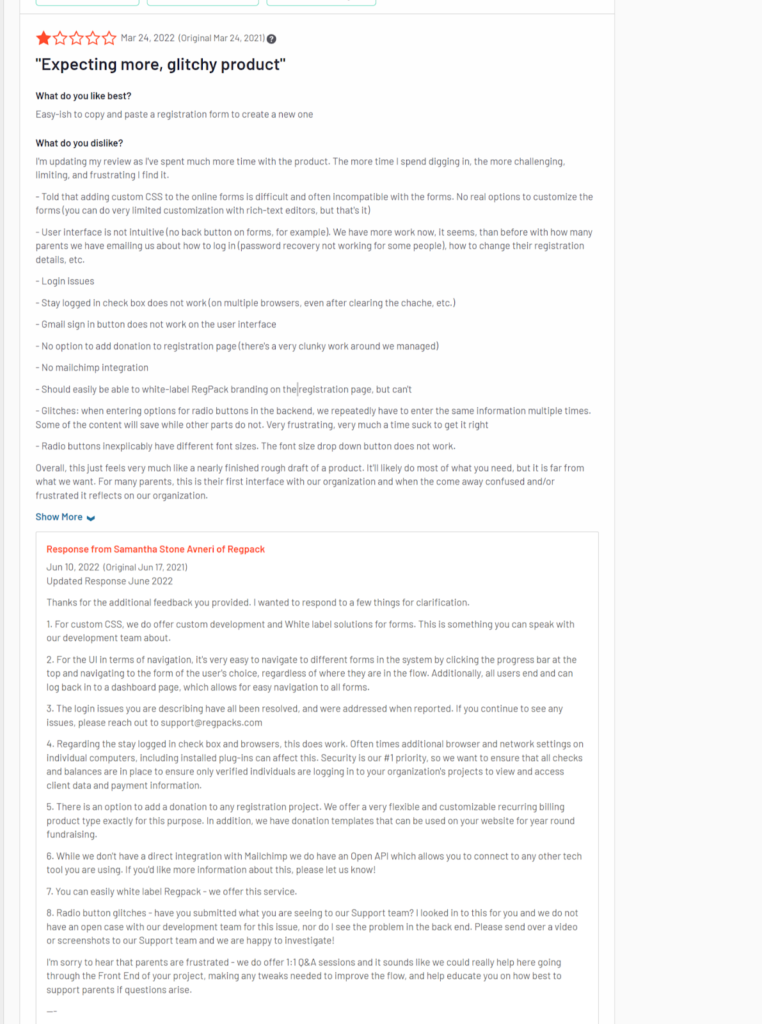
Why this response is good
What makes the response in this example great is how the responder takes the time to address each problem the user raised, providing explanations without any hint of irritation. The responder also proposes a QA session and points the user to an email for further support.
Example 2

Why this response is good
In this Pipedrive example, the response starts by addressing the user by their name to show it’s not just a copy-and-paste response. Next, it appreciates the feedback before apologizing for the poor experience. It also offers support by providing a link to the support team for English and Portuguese. Lastly, the company offers to ensure that the dedicated department has contacted the user for the reported issue.
Example 3

Why this response is good
In Colbie’s response above, her full name and position at Zoominfo are visible, projecting transparency. She thanks Dylan for the review both at the beginning and end of her response and informs him of what she’s done to try to solve the issues he raised.
Example 4
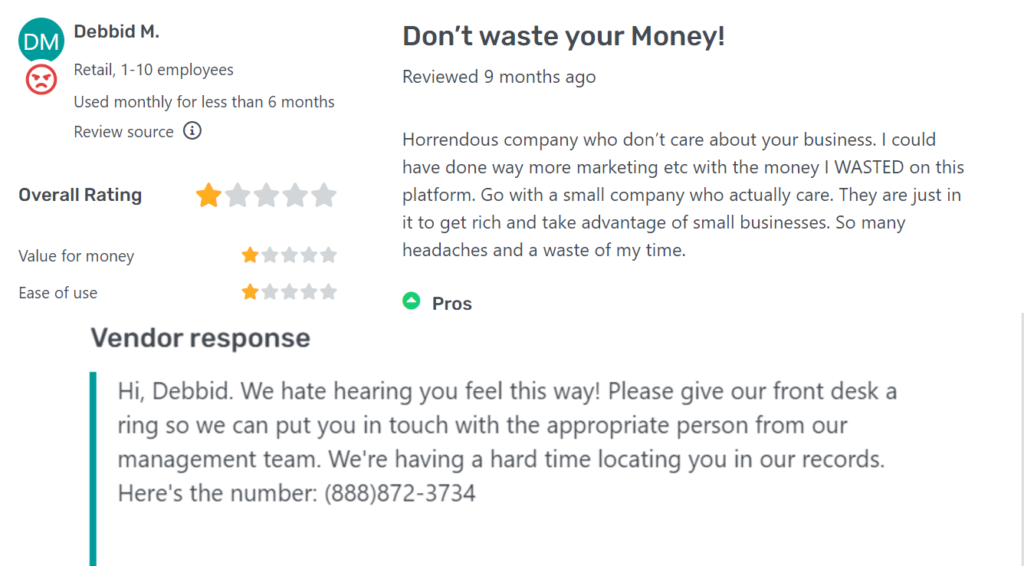
Why this response is good
In the response above, the responder expresses regret for the user’s experience, addressing them by name. The responder indicates that they’ve tried to find a user in their system without success, before asking the user to reach out, providing a direct phone number.
Example 5
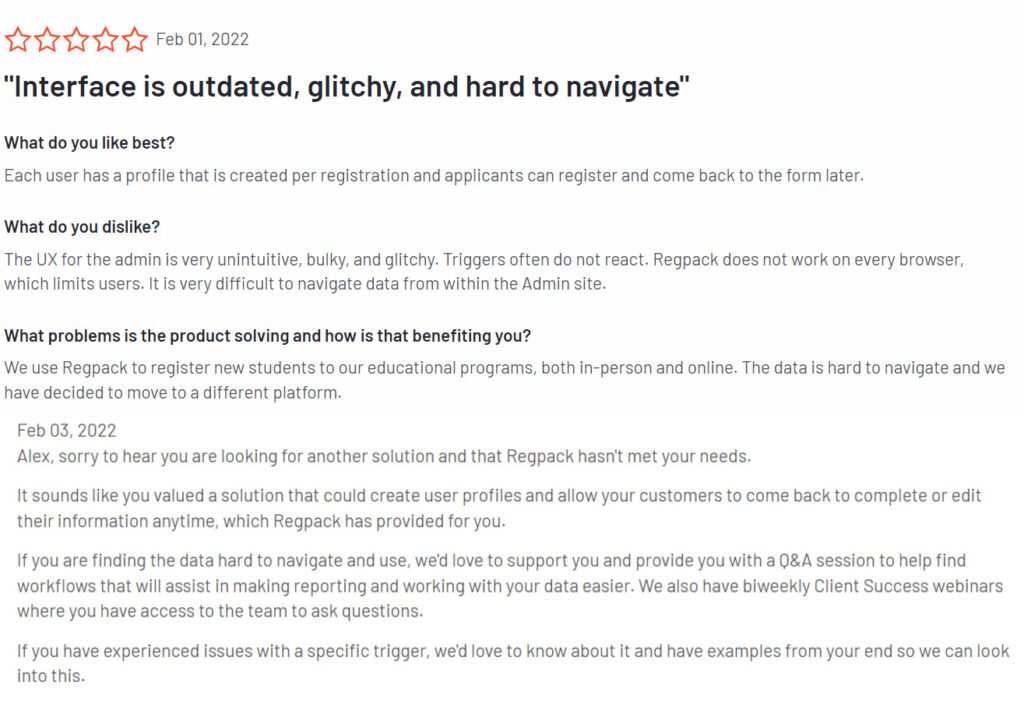
Why this response is good
In the Regpack example above, the user says that they’ve decided to move on from the software, which can easily provoke a cold response. But the responder above remains polite, apologetic, and empathetic of the user’s experience. Impressively, the responder extends support without being pushy, which leaves the user to decide if they want to accept the help and give the software another chance.
Example 6
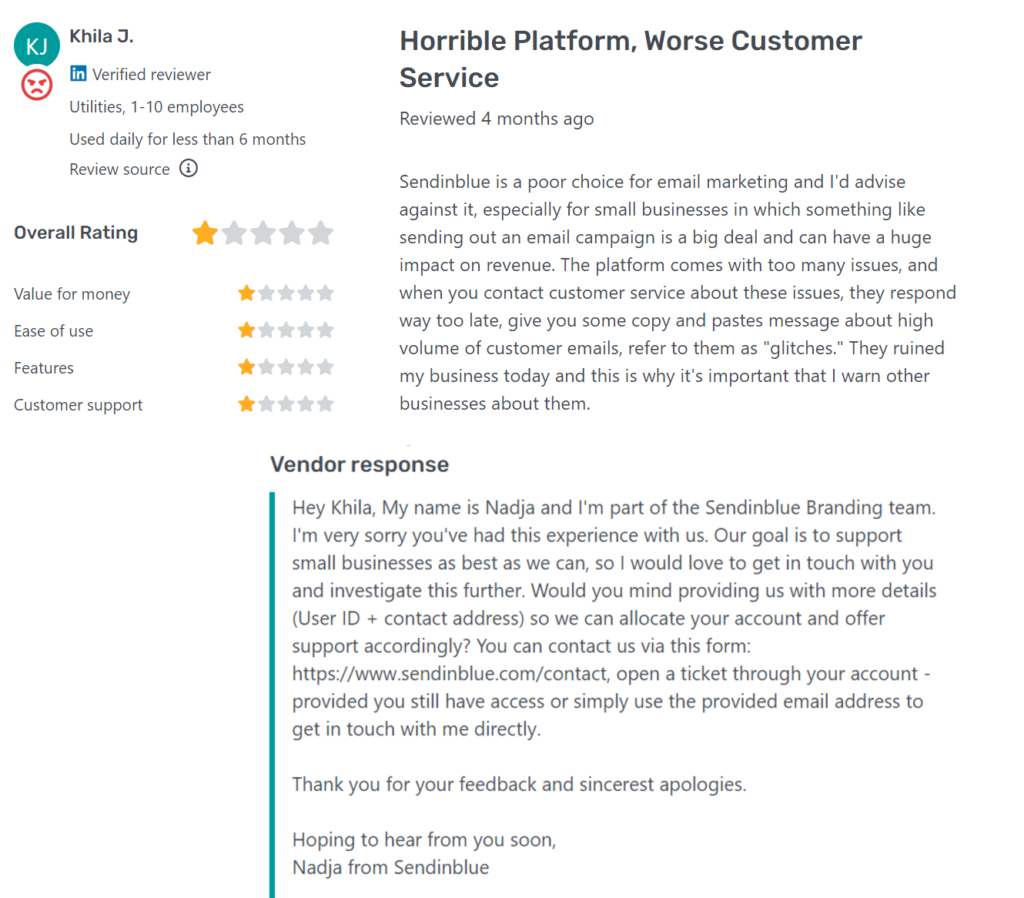
Why this response is good
In the response above, the responder, Nadja, begins with an introduction and remains empathic and contrite throughout the response. Nadja reiterates Sendinblue’s mission and politely asks the user to reach out, walking Khila through how and where to do this.
Example 7
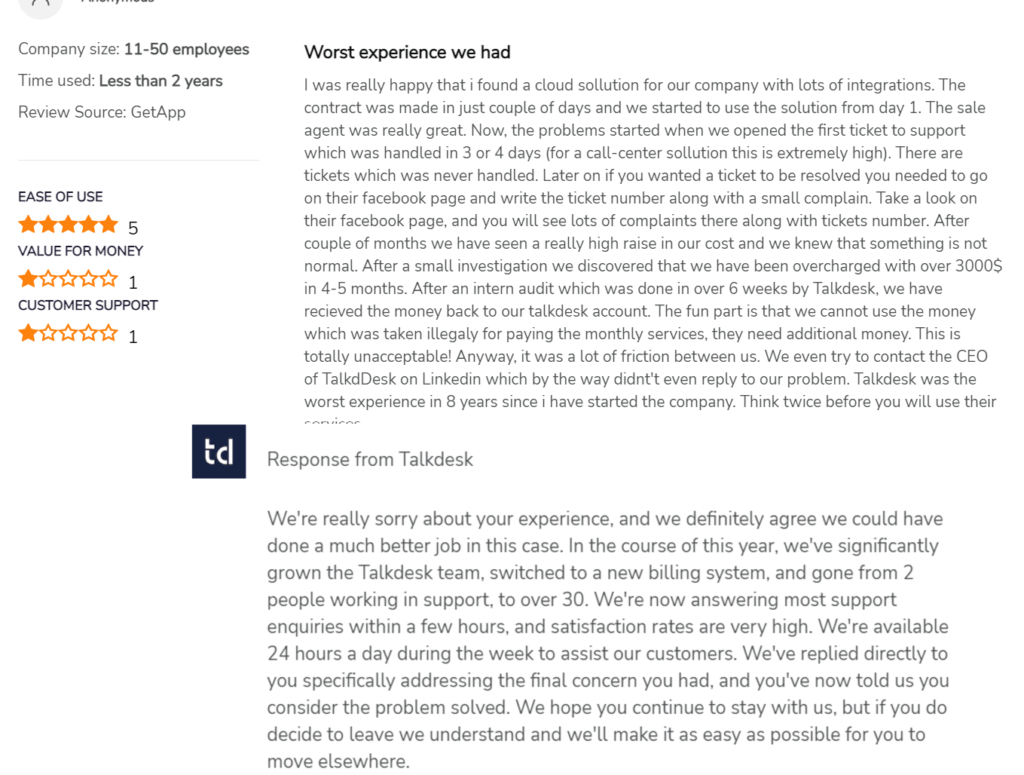
Why this response is good
In this response, Talkdesk takes responsibility for the users’ experience, admitting that they could have done better. Talkdesk tells the user what the company has been doing to improve the customer experience, assuring the user that support is available for 24 hours. Finally, they recognize the user’s desire to leave and pledge to make the process easy for them.
Example 8
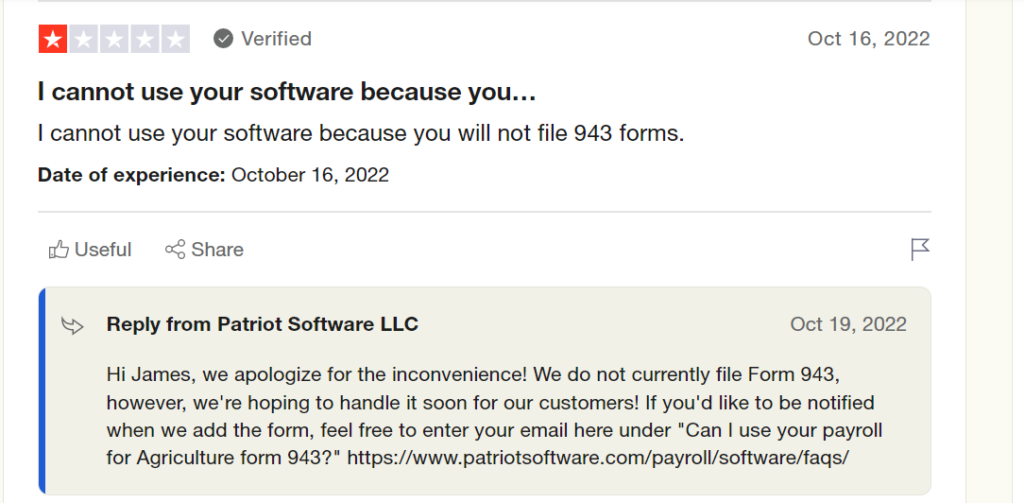
Why this example is good
In the example above, the user wants to carry out a task that the software is not equipped to do. The responder apologizes for the inconvenience and takes the opportunity to inform the user that this service is coming soon. Then directs them to enter their email if they want to be notified when the service is ready.
Example 9
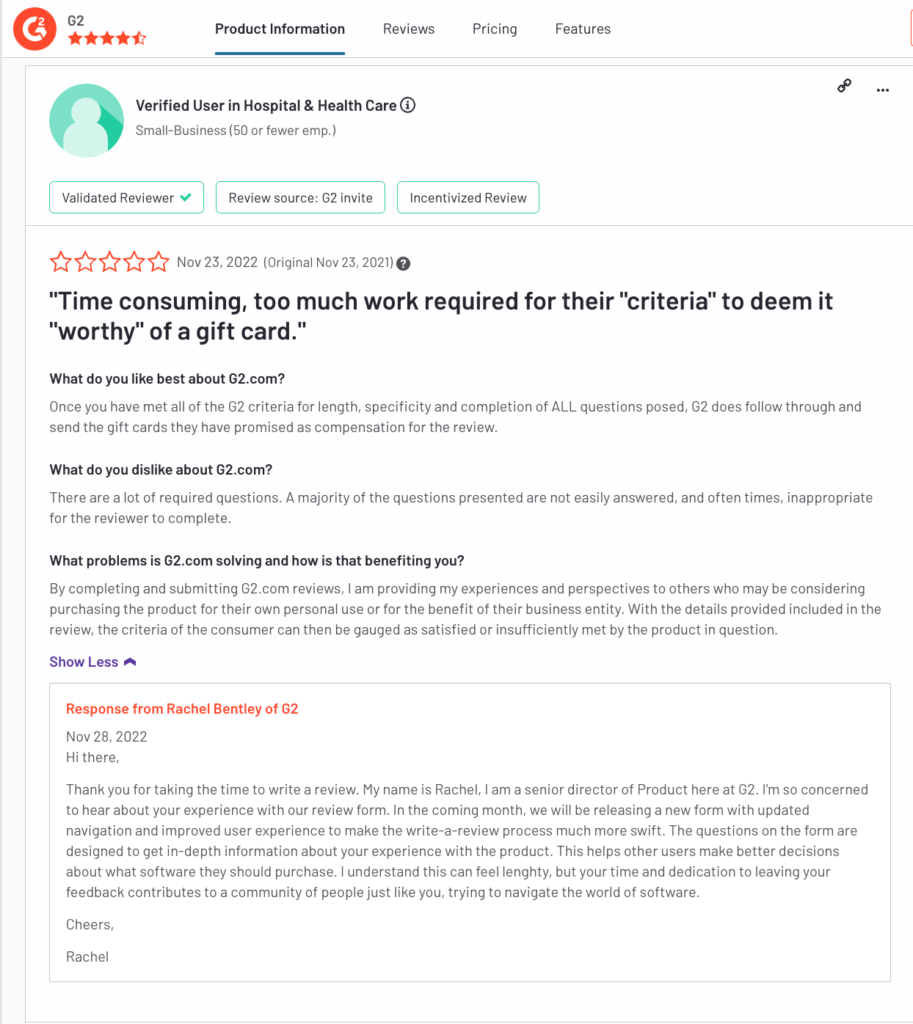
Why this example is good
In the response above, the reviewer is frustrated by the user experience of leaving a G2. So who better to respond to it than G2’s Sr. Director of Product Management, Rachel Bentley? The messenger is part of the message. By having a senior product leader as the messenger to the user review, G2 communicates to the reviewer and those reading it that they care about this user feedback.
The content of the message is also well done. Rachel starts by thanking the reviewer for taking the time to provide a detailed response. She introduces herself to provide added credibility. Then she empathizes with the user’s experience and shares how G2 is working to address the specific product issues raised and when they’ll be delivered. She ends by sharing her perspective on the issue so help the reviewer and readers of the review get a better understanding of their approach to the issue.
Conclusion
When companies invest in your software, they invest in a potential relationship with your company. Responding to reviews shows that providing customer service is important to you. And how you respond creates a perception of how you treat your customers.
To engage your customers and build your brand’s reputation, keep your responses positive and professional, respond on time, and offer practical solutions to any challenges they have with your software.
If you’d like to get more reviews from your users or wondering how to win more accounts with your existing user reviews, here’s a guide for you.
To learn more about responding to reviews in B2B SaaS, read G2’s post How to Make Reviews Actionable: A Guide to Delighting Customers.
Authors
-
-
I'm the Founder and Editor-In-Chief of B2B SaaS Reviews. I'm also the Director of Demand Generation at PartnerStack, the #1 platform purpose-built for partner management and affiliate marketing in B2B SaaS. Before PartnerStack, I worked for other go-to-market B2B SaaS companies: Influitive (Advocate Marketing designed to generate more reviews, references, and referrals), LevelJump (Sales Enablement) (acquired by Salesforce) and Eloqua (Marketing Automation) (acquired by Oracle).






